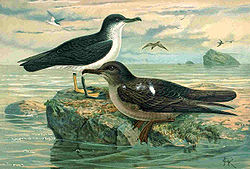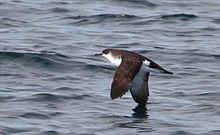- Manx Shearwater
-
Manx Shearwater 
Puffinus puffinus (left) Conservation status Scientific classification Kingdom: Animalia Phylum: Chordata Class: Aves Order: Procellariiformes Family: Procellariidae Genus: Puffinus Species: P. puffinus Binomial name Puffinus puffinus
(Brünnich, 1764)Synonyms Procellaria puffinus Brünnich, 1764
The Manx Shearwater (Puffinus puffinus) is a medium-sized shearwater in the seabird family Procellariidae. The scientific name of this species records a name shift: Manx Shearwaters were called Manks Puffins in the 17th century. Puffin is an Anglo-Norman word (Middle English pophyn) for the cured carcasses of nestling shearwaters. The Atlantic Puffin acquired the name much later, possibly because of its similar nesting habits.[1]
Contents
Description
This bird is 30–38 cm long, with a 76–89 cm wingspan. It has the typically "shearing" flight of the genus, dipping from side to side on stiff wings with few wingbeats, the wingtips almost touching the water. This bird looks like a flying cross, with its wing held at right angles to the body, and it changes from black to white as the black upperparts and white undersides are alternately exposed as it travels low over the sea.
Taxonomy
At some time or another, every living one of the middle-sized species of Puffinus has been considered a subspecies of P. puffinus. The extant Yelkouan Shearwater and Balearic Shearwater (Sangster et al. 2002), Hutton's Shearwater[citation needed], Black-vented Shearwater[citation needed], Townsend's Shearwater[citation needed], the Hawaiian Shearwater[citation needed], and the Fluttering Shearwater[citation needed] are now considered good species. Of these, only the Hawaiian and possibly Townsend's Shearwaters seem to be somewhat closely related to the Manx Shearwater (Austin 1996); the former Puffinus puffinus "superspecies" has turned out to be a number of more or less distantly related lineages. However, including the extinct forms listed below, at least the Mediterranean taxa do apparently constitute a superspecies in their own right, and maybe the New Zealand ones also.
Also belonging to this complex seem to be several extinct species:
- Lava Shearwater or Olson's Shearwater, Puffinus olsoni from the Canary Islands, as was
- Hole's Shearwater, Puffinus holeae, which also occurred on the western coasts of Iberia, and
- Scarlett's Shearwater, Puffinus spelaeus of South Island, New Zealand;
undescribed remains found on Menorca may belong to an already-named or a new taxon; they are not from the Balearic Shearwater (Alcover 2001) which is possibly closer to P. holeae than to any other known species, living or extinct[citation needed]. There also existed a Late Pliocene/Early Pleistocene species known from Ibiza, Puffinus nestori, which may have been the direct ancestor of the Mediterranean Shearwater (Heidrich et al. 1998).
The Atlantic forms are parapatric whereas the Pacific forms are sympatric or were not too long ago (Holdaway et al. 2001) and are reproductively isolated by a different circannual rhythm.
Range and habitat
The prefix Manx, meaning from the Isle of Man, originated owing to the once large colony of Manx Shearwaters found on the Calf of Man (a small island just south of the Isle of Man). The species had declined there owing to the accidental introduction of rats from a shipwreck in the late 18th century; the rats have, however, recently been removed from the Calf of Man allowing Shearwater numbers to increase.
Behaviour
They are long-lived. A Manx Shearwater breeding on Copeland Island, Northern Ireland, was as of 2003/2004 the oldest known living wild bird in the world: ringed as an adult (at least 5 years old) in July 1953, it was retrapped in July 2003, at least 55 years old[citation needed].
This is a gregarious species, which can been seen in large numbers from boats or headlands, especially on passage in autumn. It is silent at sea, but at night the breeding colonies are alive with raucous cackling calls.
Food and feeding
The Manx Shearwater feeds on small fish (particularly herring, sprat and sardines), crustaceans, cephalopods and surface offal. The bird forages individually or in small flocks, and it makes use of feeding marine mammals and schools of predatory fish, which push prey species up to the surface. It does not follow boats.
Breeding
This species breeds in the North Atlantic, with major colonies on islands and coastal cliffs around Great Britain and Ireland. These birds have been nesting along the Atlantic coast of northeastern North America since about 1970[citation needed] and have since expanded their breeding range southward into the Gulf of Maine with a pair having been confirmed nesting at Matinicus Rock (http://www.fws.gov/FWSJournal/regmap.cfm?arskey=26734&callingKey=state&callingValue=ME). They nest in burrows, laying one white egg which is only visited at night to avoid predation by large gulls. The islands are usually free of mammalian predators (but on the island of Rùm, about 4 percent of the chicks are preyed on by Red Deer and sheep that need extra calcium.)[2] They form life-long monogamous pair-bonds.
Migration
Manx Shearwaters migrate over 10,000 km to South America in winter, using waters off southern Brazil and Argentina,[3] so this bird has covered a minimum of 1,000,000 km on migration alone (not counting day-to-day fishing trips). Another bird ringed in 1957 and still breeding on Bardsey Island off Wales in April 2002, was calculated by ornithologist Chris Mead to have flown over 8 million km (5 million miles) during its life.
Folklore
In the nineteenth century Manx novel 'The Manxman' by Sir Hall Caine, a reference is made to the satanic folklore surrounding the Manx shearwater, apparently due to its unusual call and dark appearance.
References
- ^ Lee & Haney (1996)
- ^ R. W. Furness, R. W. (1988). "Predation on ground-nesting seabirds by island populations of red deer Cervus elaphus and sheep Ovis". Journal of Zoology 216 (3): 565–573. doi:10.1111/j.1469-7998.1988.tb02451.x.
- ^ T. G. Guilford, T; Meade, J; Willis, J; Phillips, RA; Boyle, D; Roberts, S; Collett, M; Freeman, R et al. (2009). "Migration and stopover in a small pelagic seabird, the Manx shearwater 'Puffinus puffinus': insights from machine learning". Proc. Roy. Soc. B 276 (1660): 1215–1223. doi:10.1098/rspb.2008.1577. PMC 2660961. PMID 19141421. http://www.pubmedcentral.nih.gov/articlerender.fcgi?tool=pmcentrez&artid=2660961.
Further reading
- Alcover, Josep Antoni (2001): Nous avenços en el coneixement dels ocells fòssils de les Balears. Anuari Ornitològic de les Balears 16: 3–13. [Article in Catalan, English abstract] PDF fulltext
- Austin, Jeremy J. (1996): Molecular Phylogenetics of Puffinus Shearwaters: Preliminary Evidence from Mitochondrial Cytochrome b Gene Sequences. Molecular Phylogenetics and Evolution 6(1): 77–88. doi:10.1006/mpev.1996.0060 (HTML abstract)
- BirdLife International (2004). Puffinus puffinus. 2006. IUCN Red List of Threatened Species. IUCN 2006. www.iucnredlist.org. Retrieved on 12 May 2006. Database entry includes justification for why this species is of least concern
- Bull, John L.; Farrand, John Jr.; Rayfield, Susan & National Audubon Society (1977): The Audubon Society field guide to North American birds, Eastern Region. Alfred A. Knopf, New York. ISBN 0-394-41405-5
- Heidrich, Petra; Amengual, José F. & Wink, Michael (1998): Phylogenetic relationships in Mediterranean and North Atlantic shearwaters (Aves: Procellariidae) based on nucleotide sequences of mtDNA. Biochemical Systematics and Ecology 26(2): 145–170. doi:10.1016/S0305-1978(97)00085-9 PDF fulltext
- Holdaway, Richard N; Worthy, Trevor H. & Tennyson, Alan J. D. (2001): A working list of breeding bird species of the New Zealand region at first human contact. New Zealand Journal of Zoology 28(2): 119–187. PDF fulltext
- Lee, D.S. & Haney, J.C. (1996): Manx Shearwater (Puffinus puffinus), In: The Birds of North America, No. 257, (Poole, A. & Gill, F. eds). The Academy of Natural Sciences, Philadelphia, PA and The American Ornithologists' Union, Washington, DC
- Sangster, George; Knox, Alan G.; Helbig, Andreas J. & Parkin, David T. (2002): Taxonomic recommendations for European birds. Ibis 144(1): 153–159. doi:10.1046/j.0019-1019.2001.00026.x PDF fulltext
External links
- BTO BirdFacts – Manx Shearwater
- for the Copeland bird ringed in 1953:
- for the Bardsey Island bird ringed in 1957:
- Song of the Manx Shearwater – a British Library sound recording.
- Flicker Field Guide Birds of the World Photographs
- VIREO [1] Eleven images.
Categories:- IUCN Red List least concern species
- Birds of Europe
- Puffinus
- Birds of the Faroe Islands
- Birds of Turkey
- Subterranean nesting birds
- British Isles coastal fauna
- Animals described in 1764
Wikimedia Foundation. 2010.


